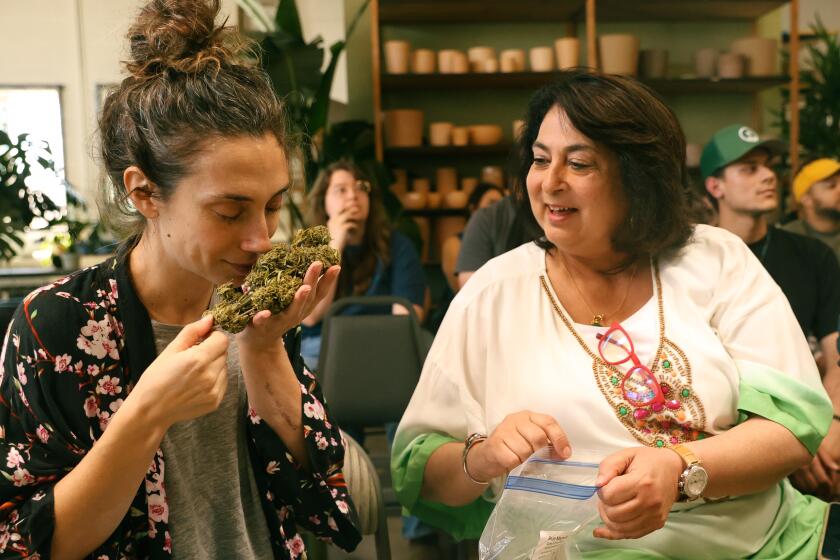Budget Cuts Pose Dilemma Among Native Americans : Aid: Many tribes favor self-governance. But others see peril in wholesale slashing of federal programs.
The yucca plants are shimmering, soon to blossom. The evenings are warmer now. Billy Martin and other spiritual elders were up late the other night for a seasonal ritual of prayer and song. Spring has come to the Navajo Nation.
But the next morning, while Martin and keepers of traditional Native American culture slept, other leaders were gathering at the nearby Crownpoint Chapter House on the Eastern Range of the great Navajo Indian Reservation. The mood was far from tranquil.
An old enemy was back, the reservation council officials warned each other, fear and anger in their eyes. It was the most despised enemy of all, the one that threatens those seeking to preserve the Native American way of life: the federal government in Washington.
In dusty jeans and braided hair, wearing faded shirts and brown, windblown faces, the tribal members lined the aisles of the one-story chapter house and harangued the button-down, pin-striped members of Congress who are waving the cudgel of fiscal reform and targeting an array of Native American programs for deep cuts.
Above all, they declared that they must stay unified if they ever hope to battle a Washington government that once again wants to dictate their future.
“Traditional Navajos used to do for themselves,” warned Leonard Arviso, a council aide from tribal headquarters at the nearby Window Rock Agency in Arizona.
“We used to plan for the next day and plan for the next year. But then we became dependent. And now that’s why we’re saying we have got to get it back together again.”
Native Americans, more than any other minority in the United States, stand perhaps to lose the most in the budget-cutting spree that has swept the nation’s capital.
While others among the poor and those on the fringes of society rely on individual subsidies from the government, no group like the Native Americans has come to depend so heavily on so much public assistance--from monthly bags of rice and beans to basic health care and housing. Even the land under their feet, the giant reservations and the small tribal parcels that cover large swaths of America, were once assigned to them by the government in Washington.
And now, as the social standing of many Native Americans continues to worsen, Congress is moving toward reducing many assistance programs and turning much if not all of the “Indian problem” over to the states or tribal councils. If successful, it would loosen a century-old partnership between Washington and the reservation, a relationship that many critics and even some Native American leaders long have charged is flawed and doomed to fail.
They point to a Bureau of Indian Affairs that has lost or squandered many millions of dollars over the years; individual assistance programs that have been mismanaged by tribal governments, and an unchanging, bitter life cycle for many Native Americans in a world of poverty, disease and despair.
“I want to do away with the BIA, period,” said Rep. Bill Richardson, a New Mexico Democrat who on one hand decries the GOP cuts in Native American assistance but at the same time has given up trying to defend the federal government’s programs.
“It’s all a big waste,” he said.
But therein lies perhaps the greatest quandary: Even should the idea of devolution--shifting government policy from Washington to the local level--descend upon the reservation, many believe that Native American leaders are ill-prepared at this stage to govern themselves. “The world is changing. We can’t live like our grandfathers did,” said Alice Benally, a social worker for Navajo youths trapped in a world of high-school dropouts, teen-age pregnancies and, more recently than ever, teen-age suicides.
“But we also really are not prepared to take over right now. We would need more education and guidance. It’s like a child. A child can’t just get up and walk on his own.” Others are more optimistic. They find faith in the ability of humankind to rise to new challenges.
“For us, it can’t get any worse. It can’t. It can’t,” said A-Lul’koy Lotah, a member of the small Chumash band in the Santa Ynez Mountains of Southern California.
Her first name means “dolphin” and her last name “bow,” and she has set up an Owl Clan Consulting firm near Lompoc that has two goals: to train tribe members how to succeed in business off the reservation, and also to teach them to hold onto and nurture their traditional culture and values.
She said that Native Americans now more than ever have a “blessed opportunity” to succeed on their own, if for no other reason than that things have become so desperate after a century of failure.
“The only worse it could get is if they came out and massacred us and took us off the face of the Earth,” she said. “We’ve been just surviving on our own for so long.”
To be sure, not all tribes are dependent on federal money. Some have found fortunes in reservation gambling. Bingo parlors and casinos have bloomed like the yucca across Native American lands. Experts estimate the Native American gambling industry is a $6 billion-a-year venture.
But many tribes, like the Navajos here, the largest community of Native Americans in the United States, disdain those kinds of profits. They fear the ills that can accompany gambling are not worth the risk for Native American societies already depressed with other societal problems.
“We got the bingo and a casino, but who knows what will come with the money,” said Richard Angulo, a Chumash spiritual leader in California who remains skeptical about his tribe’s future.
In fact, a lot of what is good in America has passed the Native Americans by. The litany reads like a modern-day Trail of Tears:
* According to the 1990 Census, a third of the 1.8 million Native Americans, including Eskimos and Aleuts, in the United States live below the poverty level. For every $100 earned by a U.S. family, a Native American household brings in $62. The per capita income for a Native American living on the reservation is less than $5,000 a year.
* Just under half of those older than 25 and living on the reservation are high school dropouts. Among teen-agers, the suicide rate is four times higher than all other ethnic groups in America.
* More than a quarter of the Native American families are headed by women with no husbands. One in five families lives in a home with no toilet or telephone.
* In 1993, the Indian Health Service found that Native American tuberculosis rates exceeded all other ethnic groups by 400%, and by more than 900% over whites. The mortality rate for diabetes exceeds the national average by 139%. Native Americans also are four times more likely to die of alcoholism than other groups in the United States, and the fetal alcohol syndrome rate is six times the national average.
Against this backdrop, federal assistance has been steadily decreasing.
Washington spent $3.4 billion in 1991 on Native Americans, up $700 million from the year before. But when that figure is adjusted for inflation, it is nearly 40% less than the dollars allocated 20 years ago.
And as Washington attempts sweeping changes this year in the way it deals with Native Americans, tribal leaders remain skeptical about whether the government has their best interests at heart. Since the last of the great Western tribes were moved onto the reservations at the end of the 19th Century, more than 300 treaties with the tribes have been broken.
“After they get through with all of their promises and all of their bureaucracies, what does it all come down to for the people?” asked Martin, the Navajo elder who by midafternoon was finally stirring awake in his hogan after the spring ritual held the night before.
“Nothing but crumbs.”
The first round of congressional measures cut deep.
The House, in earmarking reductions in federal programs from last year, voted to knock off, among other things, $1.5 million from Special Tribal Court programs on the reservations, $6.4 million from the Native American Job Training Program and $1.3 billion--total elimination--from the Low Income Home Energy Assistance initiative.
In the Senate, lawmakers would take almost $6 million from BIA education, housing and general operations programs.
A conference of House and Senate members will meet in the coming months to reconcile the proposed cuts. Also on the table will be more than $40 million slashed from a series of Native American museum projects, including a National Museum of the Native American proposed for prominent display on the Washington Mall.
Sen. Daniel K. Inouye (D-Hawaii), long an advocate of Native American assistance and a major promoter of the national museum, noted with underscored irony that there are more than 300 statues gracing the nation’s capital, yet none commemorates a Native American. “I think this rather strange and obscene.”
He and others decry wholesale cutting of Native American programs and urge instead the adoption of concrete plans to reshape the roles of the government and the tribes.
Dr. Michael H. Trujillo, assistant surgeon general and director of the Indian Health Service, recently told Congress that it is “imperative that the IHS manage its resources efficiently.”
But he also warned that wholesale reductions “will, without a doubt, affect our resources and, ultimately, the delivery of health care.”
To get around the political hazards of blindly cutting programs, some Washington officials favor turning general assistance over to the states in the form of block grants. They are weighing the idea of either having the states handle block grants for Native Americans living within their borders or fashioning the Native American programs into a kind of special “51st state” with block grants paid directly to the tribes.
“Tribal concerns are best addressed at the tribal level,” said Bruce Babbitt, who, as secretary of the Interior, oversees the assistance programs to Native Americans.
For 20 years, Native American leaders have sought block grants of their own, separate from the federal agencies that now administer programs. They have argued that this would help put them on the path to self-governance. Now they worry they may be passed over while the 50 states are awarded block grants.
Last month, when the House took up the welfare reform bill, a proposal to do just that--create a block grant system that includes Native Americans as a separate “state”--was defeated in the Rules Committee and never made it to the House floor.
A second chorus of policy-makers would do away with the Bureau of Indian Affairs. They believe the time has come to end the longstanding BIA system that many government and tribal officials now agree never really worked.
In recent years, the case against the BIA has been mounting.
In May, 1992, Congress’ General Accounting Office found “longstanding control weaknesses” in the agency, including problems such as “unjustified, improper and inconsistent payments, as well as significant potential for fraud and waste” in its myriad assistance programs.
A month later, the GAO criticized the BIA for improperly managing and failing to reconcile $2 billion in trust funds accumulated from Native American royalties on oil, gas, mineral and land-use agreements. The GAO noted that internal BIA auditors had worked for more than seven months and still were unable to reconcile the books.
“Missing records continue to be a problem,” the GAO said. “The BIA has not developed a strategic plan for improving its trust fund management.”
That kind of mismanagement has angered many key Washington lawmakers, including Sen. John McCain (R-Ariz.), the new chairman of the Senate Committee on Indian Affairs.
Estimating that “mismanagement and poor investments” have cost the BIA between $25 million and $30 million in tribal and individual trust money, McCain has pledged to reform or bury the agency, which acts as a funnel in administering the various Native American assistance programs.
He noted that BIA schools set up on many reservations are in disrepair, that children sit in classrooms that have been structurally condemned and that students live in dormitories that the Inspector General’s Office has described as “uninhabitable.”
He noted that fire safety on some reservations amounts to nothing more than stripped-down firetrucks that have no hoses, axes or other equipment, which are supposed to respond to fires in buildings that have faulty alarms.
“The fire protection plan for many of these BIA schools is to evacuate the premises and watch it burn to the ground,” McCain said.
Declaring that “a parade of horribles” has been imposed on Native Americans, he added: “The Bureau of Indian Affairs has been shamefully neglectful.”
But Clinton Administration officials are not ready to give up on the BIA, including Ada Deer, an assistant secretary for Indian Affairs who runs the BIA.
She argues that Native American self-determination policy is based on unique relationships between Washington and the tribal communities. “Many of our Indian tribes entered into their ‘contract with America’ through treaties signed over 100 years ago--not this past November,” she said at a recent hearing, referring to the legislative agenda partly credited for the Republican sweep in the fall elections.
On the House side of Capitol Hill, Native American leaders also have been pushing for more, not less. Their argument for continued assistance goes back to treaties signed between Washington and sovereign tribal nations over the last century and before.
“We are not states,” said Gaiashkibos, president of the National Congress of Americans and tribal chairman of the Lac Courte Oreilles Band of Lake Superior Ojibwa. “We are not counties. We are not clients. We are not customers. And we are not simply an ethnic group. This government cannot turn a blind eye to the basic human needs of our nation’s 2 million Native Americans.”
His cry--for help, not abandonment--also is heard on the reservations. But there, where oftentimes the mere price of gasoline or a new suit of clothes prevents someone from going to town in search of a job, the larger worry that nags in the back of their minds is whether they are capable of doing for themselves.
How can they ever exist in a modern age of supersonic travel and computer wizardry? How do you assimilate when your family tradition in the Navajo world is grazing a small herd of sheep? How do you compete when your children follow your example and choose alcohol over education?
“The people are not ready for this,” said Arviso, the tribal council leader.
Outside, Billy Martin is up and headed toward the assembly house. “I’m kind of mad and I’m kind of angry, and I don’t like what Washington is doing either.”
However, his neighbor, John Willie, a longtime medicine man, shuns the crowded meeting hall. He turns instead to his daily duties tending 30 sheep and the physical and spiritual ailments of many of his fellow Navajos. But even he pledges to do his part to make sure this spring season does not turn into a sundown on the reservation.
“I pray these cuts will not be coming,” he said.
More to Read
Start your day right
Sign up for Essential California for news, features and recommendations from the L.A. Times and beyond in your inbox six days a week.
You may occasionally receive promotional content from the Los Angeles Times.







